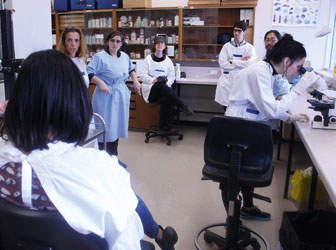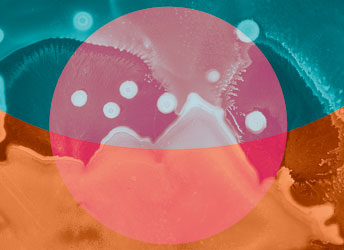PLEASE SCROLL DOWN FOR THE ENGLISH
VERSION
Nonhuman Subjectivities
The Other Selves. On
the Phenomenon of the Microbiome
François-Joseph Lapointe, Saša Spacal mit Mirjan Švagelj und Anil
Podgornik, Tarsh Bates, Joana
Ricou
Vernissage: 26. Februar 2016,
20 Uhr
Künstler/innengespräch: 28 Februar 2016, 15Uhr
Ausstellung: 27. Februar – 30. April, 2016 || Fr-So
14-18 Uhr u.n.V. (von 25.- 27. März geschlossen)

Links:François-Joseph Lapointe, Microbiome
selfie, 2014 Mitte & rechts: Saša Spacal, Mirjan Švagelj, Anil
Podgornik Mycophone Unison, Responsive Installation: Elektronic, Klang,
und biologische Materialen, 2013; Petri dish, Installation Detail
2013
Die Ausstellung, die erste unserer neuen Ausstellungsreihe
Nonhuman Subjectivities,
zeigt verschiedene
künstlerische Positionen zum komplexen mikrobiellen Milieu am und im
menschlichen Körper. Wissenschaftler behaupten, dass es genauso viele Bakterien
wie menschliche Zellen in unserem Körper gibt. Das Phänomen des Mikrobioms wirft
also eine Menge grundlegender Fragen über die menschliche Identität und unsere
Beziehung zu unseren multiplen Entitäten auf.
François-Joseph Lapointe verbindet seine
biologische Forschung mit Performancekunst. Seine jüngsten künstlerischen
Arbeiten thematisieren das Mikrobiom in Verbindung mit unserem alltäglichen
Leben und der physischen Beziehung zu anderen. Lapointe sequenziert sein eigenes
Mikrobiom, um metagenomische Selbstportraits zu schaffen, sogenannte
Microbiome Selfies, welche die Metamorphose seines bakteriellen Selbst
illustrieren. In der Ausstellung werden neue Arbeiten seiner Performance
1000 Handshakes zu sehen sein, die er vor kurzem in der
Eröffnungsnacht der transmediale 2016 realisierte. Die Bilder zeigen den mikrobiellen
Verlauf während der Interaktion mit dem Mikrobiom anderer - so zum Beispiel beim
Händeschütteln, einer grundlegenden und uralten Form der
Beziehungspflege.
Saša Spacal zusammen mit Mirjan Švagelj und Anil
Podgornik untersuchen die Dichotomie des Einsseins des menschlichen
Körpers zwischen biologischer Einheit zum einen und Vielheit des menschlichen
Mikrobioms zum anderen. In ihrer Installation Mycophone_unison
entwickelte das Kunst-Wissenschaft-Design-Team eine auditive Landkarte der
Interaktionen ihrer Mikrobiome und uns Rezipienten: Indem die Besucher ihren
Fingerabdruck hinterlassen, senden sie ein Signal an die Karte, die dies durch
die zentrale Himmelsplatte an die drei Mikrobiome weitergibt und verarbeitet.
Die polymodale Sonifikation betont dabei die Vielfältigkeit der Macher/innen.


Links: Tarsh Bates bei der Arbeit im Labor für
künstlerische Produktion, School of Pathology and Laboratory Medicine, The
University of Western Australia, 2015
Rechts: Joana Ricou, Other
landscape no. 1, Mikrobiom der Künstlerin und Umgebung,
C-print, 89 × 140 cm,
2014
Tarsh Bates
untersucht künstlerisch, was es bedeutet, Mensch zu sein, wenn unser Körper mit
mehr als einer Billion Zellen ausgestattet ist, von denen doch nur die Hälfte
menschliche sind. Ihre neue Arbeit Surface dynamics of adhesion besteht
aus einem beflockten Tapetenmodell. Auf der Grundlage des Bluts der Künstlerin
und in Plexiglas-Rahmen dicht verschlossen entwickelt ein Candida
bestimmte Muster, die in den Salons der viktorianischen Zeit populär waren.
Die Arbeit ermöglicht ästhetische Erfahrungen über die Kontaktzonen zwischen
den zwei völlig unterschiedlichen Organismen. Darüber hinaus thematisiert die
Installation die unbewusste Beziehung, die wir zu Candida
haben.
Joana Ricous
Fotografien, mikrobielle Gemälde und Performances verlaufen jenseits der
traditionellen Grenze zwischen Organismus und Umgebung. Ricou sammelt Proben
ihres eigenen Mikrobioms und das ihrer Umgebung, kultiviert diese im Labor, um
sie anschließend zu visualisieren. Daraus sind zwei Portrait-Serien entstanden:
Other-self Portraits, ein Gemisch von Kulturen ihres eigenen Körpers;
und Non-self Portraits, ein
Gemisch von umgebenden Kulturen.
Regine Rapp & Christian de Lutz
(Kuratoren)
http://artlaboratory-berlin.org/html/de-presse-aktuell.htm
Pressetext als.pdf
Mit freundlicher Unterstützung von:
Medienpartner:
Besonderen Dank an:

Ermöglicht durch eine großzügige Unterstützung
von Michael Schröder
.

Regine Rapp, Christian de Lutz
Prinzenallee 34, 13359 Berlin
www.artlaboratory-berlin.org
presse@artlaboratory-berlin.org
************************************
Nonhuman Subjectivities
The Other
Selves. On the Phenomenon of the Microbiome
François-Joseph Lapointe, Saša
Spacal with
Mirjan Švagelj and Anil Podgornik, Tarsh Bates, Joana
Ricou
Opening of the exhibition: 26
February, 2016,
8PM
Artists' Talk: 28 February, 2016, 3PM
Exhibition runs: 27 February – 30 April, 2016
|| Fri-Sun 2-6PM and by appointment. Closed Easter weekend (25 – 27
March)

left: François-Joseph Lapointe, Microbiome selfie,
2014, center & right: Saša Spacal, Mirjan Švagelj, Anil Podgornik Mycophone
Unison, Responsive installation: electronics, sound, and biological material,
2013; Petri dish, detail of installation 2013
The exhibition, the first of our new exhibition series
Nonhuman
Subjectivities, presents various artistic reflections on the complex microbial environment found
on and within the human body. Scientists say that bacterial cells are as
numerous as human cells in our body. The phenomenon of the microbiome also
brings forth many complex questions about human identity and our relation to our
multiple selves.
François-Joseph
Lapointe connects his biological research with performance art. His
latest works of art deal with the microbiome in our daily lives and physical
connections to others. Lapointe sequences his microbiome to produce metagenomic
self-portraits, Microbiome Selfies, which illustrate the metamorphosis
of his bacterial self. The show will present works from his performance 1000
Handshakes, performed at the opening night of the 2016 transmediale. The
final images visualise the microbial change from interacting with someone else’s
microbiome – by shaking hands, a basic and ancient act of
networking.
Saša
Spacal
together with Mirjan Švagelj and Anil
Podgornik are interested
in the contrast between the oneness of the human body as biological entity and
the multiplicity of the human microbiome. In their installation Mycophone_unison
the artist-scientist-designer collective has developed a sound map of
intra-action between their microbiomes and the recipient. By leaving a
fingerprint the viewer sends a signal to the map that processes it through the
central celestial plate to the microbiomes. The polymodal sonification stresses
the multiplicities of the makers.

Left:
Tarsh Bates working in the science lab for artistic
production, School of Pathology and Laboratory Medicine, The University of
Western Australia, 2015
Right: Joana
Ricou, Other landscape no. 1, microbiome of the artist and environment, C-print,
89 × 140 cm, 2014
Tarsh Bates
artistically explores what it means to be human when we recognise our bodies as
composed of over one trillion cells, of which only around half are human. Her
new work Surface dynamics of adhesion is a flocked wallpaper sampler.
Encased in acrylic boxes, living Candida, with blood from Bates
herself, form patterns from wallpaper popular in the parlours of Victorian
Britain. The work offers aesthetic experiences from the contact zones between
the two different organisms, and highlights the unconscious relation we have
with Candida.
Joana Ricou’s works blur the
fundamental boundary between organism and environment, taking the shape of
photographs of microbial paintings or performance. Ricou collected samples of
her own microbiome and that of her environment and cultured these in the lab to
visualise them. Out of this two portraits emerged: Other-self Portrait,
a composite of cultures derived from her body, and Non-self Portrait, a composite of environmental
cultures.
Regine Rapp & Christian de Lutz (curators)
http://artlaboratory-berlin.org/html/eng-press-current.htm
Press text as .pdf
Supported by: 
Media partner:

Special thanks to: 

Made possible in part by a generous gift from
Michael Schröder.
Regine Rapp, Christian de Lutz
Prinzenallee 34, 13359 Berlin
www.artlaboratory-berlin.org
presse@artlaboratory-berlin.org